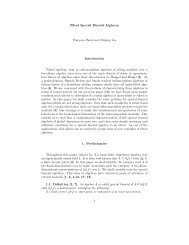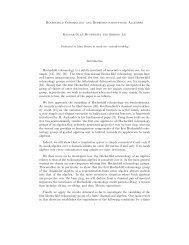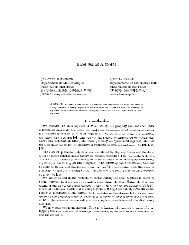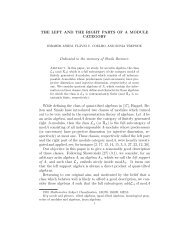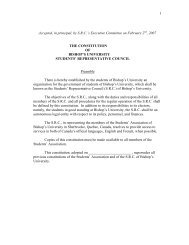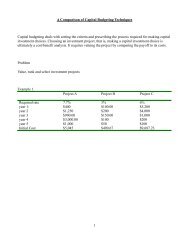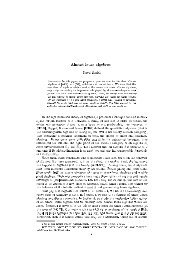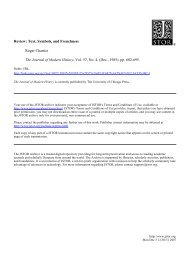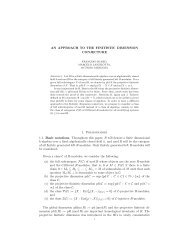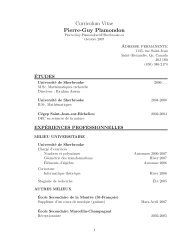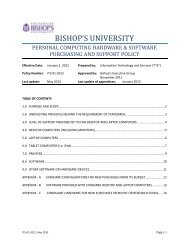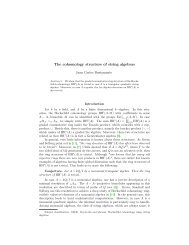Biological Sciences - Bishop's University
Biological Sciences - Bishop's University
Biological Sciences - Bishop's University
Create successful ePaper yourself
Turn your PDF publications into a flip-book with our unique Google optimized e-Paper software.
Biology • 153<br />
BIO 206b Diversity of Life II 3-3-0<br />
Like its companion course BIO 205a, this course explores the tree of life, but from a<br />
less animal-centric view. We study the prokaryotes at the root of the tree, responsible<br />
for more than half of the earth’s biomass. Next, we examine the branch that contains all<br />
fungi (and lichens). The various protists and those algae that are not related to green<br />
plants form other branches, which we will also explore. Finally, we study in more detail<br />
the largest group of eukaryotes by biomass, the green plants. The material in this course<br />
(and in BIO 205a) is organized according to a modern phylogenetic framework. The<br />
focus will be on diversity, function and ecological importance. In the case of the green<br />
plants, we look at the reasons for the tremendous ecological success of this form of life.<br />
We examine photosynthesis, transport, reproduction and life cycles, and evolution,<br />
empathizing ecological relevance.<br />
Prerequisite: BIO 191 or BIO 197;Co-requisite: BIL 206b<br />
Students with credit for BIO 116 cannot also receive credit for BIO 206.<br />
Professor van Hulst<br />
BIL 206b Diversity of Life II Laboratory 1-0-3<br />
A series of experiments and exercises to complement BIO 206b.<br />
Co-requisite: BIO 206b<br />
Students with credit for BIL 116 cannot also receive credit for BIL 206.<br />
Staff<br />
BIO 207a General Ecology 3-3-0<br />
An introduction to modern ecology: environmental patterns, patterns in the distribution<br />
of plants and animals, evolution and adaptation, ecosystem function, plant and animal<br />
populations, species interactions, community organization, applied ecology.<br />
Prerequisite: BIO 191 or BIO 197; Co-requisite: BIL 207a<br />
Students with credit for BIO 117 cannot also receive credit for BIO 207.<br />
Professor van Hulst<br />
BIL 207a General Ecology Laboratory 1-0-3<br />
Experiments and exercises in General Ecology.<br />
Co-requisite: BIO 207a<br />
Students with credit for BIL 117 cannot also receive credit for BIL 207.<br />
Professor van Hulst<br />
BIO 208b Genetics 3-3-0<br />
An introduction to the study of biologically inherited traits from three perspectives. (i)<br />
Mendelian Genetics: the rules of genetic transmission and heredity. (ii) Molecular<br />
Genetics: the biochemical and chromosomal basis of heredity. (iii) Population & Evolutionary<br />
Genetics: the variation in genes amongst individuals and populations, heritability,<br />
and changes in genes over time.<br />
Prerequisite: BIO 110 or BIO 196; Co-requisite: BIL 208b<br />
Students with credit for BIO 118 cannot also receive credit for BIO 208.<br />
Professor Boulet<br />
BIL 208b Genetics Laboratory 1-0-3<br />
Experiments in genetics designed to complement topics discussed in BIO 208b.<br />
Co-requisite: BIO 208b<br />
Staff<br />
BIO 212b Evolution 3-3-0<br />
Possibly the greatest single theory in modern science, evolution influences all aspects<br />
of biology from wildlife management to modern medicine. This course will examine<br />
both the patterns of evolution as well as the mechanism.<br />
Prerequisite: BIO 191a or BIO 197b<br />
Professor Richardson<br />
BIO 233 Human Anatomy 3-3-0<br />
The anatomy of all of the major body systems will be discussed in the context of human<br />
health and disease. This course is designed for students interested in the biomedical<br />
sciences or health education. Students will develop their understanding of human anatomy<br />
and will acquire the ability to communicate scientific concepts to their patients or<br />
students.<br />
Prerequisite or Corequisite: BIO 191 or BIO 196<br />
Corequisite: BIL 233. This course cannot be taken for credit by anyone who already<br />
has credit for BIO 131, BIO 132, or BIO 133<br />
Professor Hull<br />
BIL 233 Human Anatomy Lab 1-0-3<br />
This course will give students a solid grounding in vertebrate anatomy through dissections<br />
and preserved material. Dissection material will include either in part or whole,<br />
several mammalian species including sheep, cat, cow, and pig. Material will focus on<br />
the recognition and development of the major organs and systems such as the skeletal,<br />
muscle, nervous, reproductive, excretory, and digestive systems. Although general<br />
mammalian structure will be examined, the relevance of these structures to human<br />
anatomy will represent the major focus of the course.<br />
Corequisite: BIO 233<br />
Students with credit for BIL 133 cannot receive credit for BIL 233<br />
*BIO 245a Field Biology I* 4-5-30<br />
An intensive, three-week long course in which participants study a wide range of habitats<br />
to gain familiarity with plants and animals in the field and to learn methods of field<br />
study. Physical aspects of the environment relating to the biota are studied, as well as<br />
the plants and animals and their interactions with one another and their environment.<br />
Living organisms are brought to the laboratory for further study. Instruction is given<br />
five full days per week during a three-week period. Areas of instruction: Mosses and<br />
Lichens; Terrestrial Mammals; Insects.<br />
Prerequisite: Bio 191 or BIO 197or equivalent<br />
Staff<br />
BIO 319 History of Biology 3-3-0<br />
An outline of biological discovery from early times to the present in relation to social,<br />
historical and cultural developments.<br />
Prerequisites: BIO 205 and BIO 208<br />
Students with credit for BIO 220 cannot receive credit for BIO 319.<br />
Staff<br />
BIO 320a Programmed Cell Death 3-3-0<br />
Programmed cell death, also called apoptosis, is a normal physiological process that<br />
takes place in every type of cell in the animal kingdom. It plays a critical role in embryo<br />
development, in selective processes (immune system), in degenerative diseases and in<br />
cancer. Since the early 90’s, programed cell death is one of the fastest growing subject<br />
of research, with almost 15000 scientific publications in 2004. In this course, we will<br />
explore normal and impaired mechanisms involved in cell death, through examples<br />
taken in human medicine or in invertebrates’ development.<br />
Prerequisite: BIO 201 or BIO 110<br />
Offered in even-numbered winters<br />
Professor Chamoux<br />
BIO 321b Biogeography 3-3-0<br />
The main goals of this course are to study spatial patterns of biodiversity and to attempt<br />
to reconstruct the origin and the present distribution of both extinct and extant taxa. We<br />
start by examining the modern distribution of selected groups of plants and animals, as<br />
well as the distribution and limits of the major biomes. We proceed with an overview<br />
of the major changes in the earth’s climate and topology through geological times, and<br />
conclude with the impact of these historical changes on the evolution and the distribution<br />
of plants and animals. Techniques in biogeographical analysis will be taught and<br />
the students are expected to carry out a group project on the biogeographic history of<br />
a specific group of plants or animals. Topics such as extinction, adaptive radiation and<br />
island biogeography will also be covered.<br />
Prerequisite: BIO 205a<br />
Pre or Co-requisite: BIO 212 or BIO 197<br />
Students with credit for BIO 221 cannot receive credit for BIO 321.<br />
Offered in odd-numbered winters<br />
Professor Savage<br />
BIO 327b Advanced Ecology 3-3-0<br />
A second course in ecology that focuses on understanding relations between animals,<br />
plants, and microbes. Topics include: population growth and regulation, variation in<br />
space and time, predation (including herbivory and adaptations to avoid being eaten),<br />
parasitism and disease, symbiosis and mutualism, life history variation, regulation and<br />
manipulation of abundance, disturbance, food webs, colonization, conservation, and<br />
population viability analysis.<br />
Prerequisite: BIO 207a; Co-requisite BIL 327b<br />
Students with credit for BIO 217 cannot receive credit for BIO 327.<br />
Offered in odd-numbered autumns<br />
Professor van Hulst<br />
BIL 327b Advanced Ecology Laboratory 1-0-3<br />
Laboratory exercises to accompany Advanced Ecology. We will use 10 exercises in<br />
conservation biology using the computer application RAMAS EcoLab. These incorporate<br />
real-world ecological problems, and will give the student experience in dealing<br />
with complex systems, as well as teaching valuable notions in applied ecology.<br />
Co-requisite: BIO 327b<br />
Students with credit for BIL 217 cannot receive credit for BIL 327.<br />
Professor van Hulst



